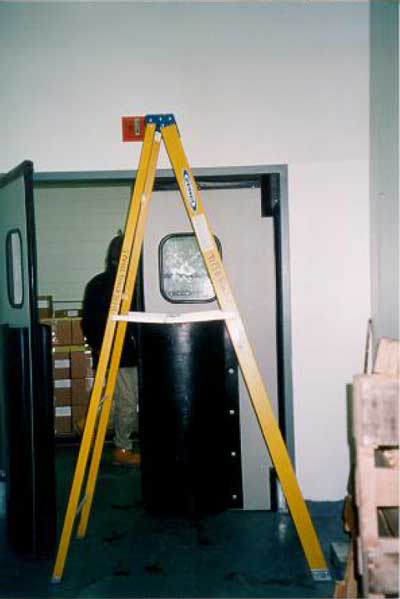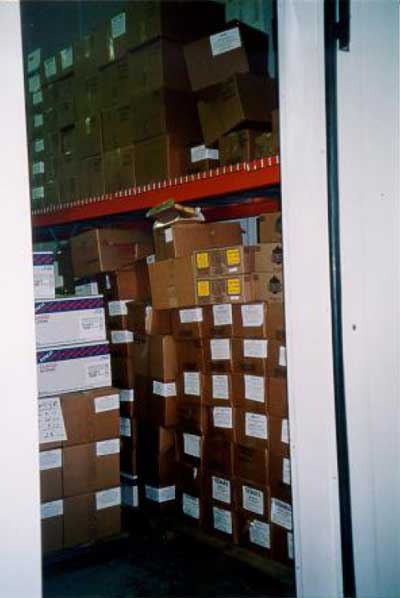Massachusetts Bakery Worker Fatally Injured in a Fall from a Stepladder
Massachusetts Case Report: 99-MA-026
Release Date: January 31, 2001
Summary
On May 6, 1999, a 48-year-old male shipper for a bakery was fatally injured when he fell from a stepladder located in a walk-in storage freezer. At the time of the incident, the victim was alone inside the freezer while using a new eight-foot fibrous glass stepladder. Office employees of the bakery heard a noise and went to find out what had caused it. They found the victim lying on the floor of the freezer with his feet on the rung closest to the floor. Two employees stayed with the victim while a third called for help. The victim was transported to a local hospital where he was pronounced dead. The MA FACE Program concluded that to prevent similar occurrences in the future employers should:
- Evaluate each task and match specific equipment needed to complete each task.
- Develop, implement, and enforce a comprehensive safety program that includes training for all employees in hazard recognition and in the proper use of equipment.
Introduction
On May 11, 1999, the MA FACE Program was notified by a Massachusetts medical examiner, through the 24-hour Occupational Fatality Hotline, that on May 6, 1999, a 48-year-old male shipper for a bakery had been fatally injured. The victim fell from a ladder inside a storage freezer. An investigation was immediately initiated. The MA FACE Program Director traveled to the incident site on May 28, 1999, where the victim’s co-workers and the bakery owner were interviewed. The death certificate, OSHA fatality/catastrophe report, witness interviews, and photographs were obtained during the course of the investigation.
The company employed approximately 45 people, 32 of them were working at the site when the incident occurred. The victim had been the only employee assigned to perform a task inside the walk-in freezer. The company did not have a designated individual in charge of safety or written safety procedures.
The victim had been employed by the company for approximately six months at the time of his death. His training was primarily on-the-job by more experienced employees, who gave basic safety warnings about ladders, specifically not to work from the top of a stepladder.
Investigation
The ladder used by the victim was a new eight-foot fibrous glass stepladder and was brought inside the freezer when needed. The walk-in storage freezer measured 20 feet by 30 feet and contained one shelf 78 inches from the floor. This allowed storage both on and below the shelf. The boxes of product stored on the freezer shelf typically were not stacked higher than approximately 41 inches. The majority of the boxes were approximately 17½ inches by 12 inches by 10 inches and on average weighed 17 pounds with a maximum box weight up to 30 pounds. The temperature inside the freezer ranged from 10oF – 20oF with a minimum temperature of 0oF. The victim spent approximately 10% – 30% of his shift inside the walk-in storage freezer gathering and restocking the different products.
Because the victim was working alone inside the walk-in storage freezer at the time of the incident, it was not clear what specific tasks he was engaged in or what caused him to fall. Interviews with the employer and co-workers suggest that he was either retrieving or restocking a box on a shelf while standing on the stepladder.
Several office employees of the bakery heard a noise that came from the direction of the freezer and went to find out what had caused it. They found the victim lying on his back on the floor of the freezer with his feet on the rung closest to the floor. There were no boxes on the floor or out of place and the ladder was in the upright position. Two of the office employees stayed with him while the owner of the company called for emergency assistance. He was then transported by the town’s ambulance to a local hospital where he was pronounced dead. The town’s police department where the incident occurred did not generate an incident report.
Cause of Death
The medical examiner listed the cause of death as blunt head trauma.
Recommendations/Discussion
Recommendation #1: Employers should evaluate each task and match specific equipment needed to complete each task.
Discussion: A rolling ladder with a platform would be a better piece of equipment than a stepladder for moving objects to different heights. Rolling ladders were designed like portable staircase for individuals to carry items, such as boxes, to higher or lower levels. The majority of rolling ladders comes complete with guardrails and a large platform above the top step of the ladder.
The FACE Program advises that stepladders not be used when carrying items, such as boxes, to higher or lower levels. Carrying objects up and down ladders and lifting objects with both hands up and over one’s head while on a step or extension ladder is hazardous. When performing these types of tasks, the employee cannot always maintain three-point contact (e.g. two feet one hand or two hands one foot) with the ladder. Maintaining three-point contact while using a step or extension ladder is necessary to minimize the hazard of falling.
Recommendation #2: The employer should develop, implement, and enforce a comprehensive safety program that includes training for all employees in hazard recognition and in the proper use of equipment.
Discussion: The company did not have a comprehensive written safety program in effect at the time of the incident. A program should be developed with the help of employees. The program should include, but not be limited to, analysis of hazards associated with any equipment that employees might come in contact with, such as ladders. Once hazards are identified the next step would be to implement controls for those hazards, and conduct training.
In this case, the victim had been employed by the company for six month and received only basic safety warnings about ladder use. As stated in the OSHA regulation 29 CFR 1910.26 employers should train employees in the proper use of ladders. The training should include, but not be limited to the proper procedure for setting up ladders and climbing up and down them. In addition, proper care and maintenance procedures should be included.
References
- Code of Federal Regulations, Labor 29 Part 1910.26 Portable Metal Ladders.
- American National Standards for ladders – portable metal – safety requirements, ANSI A14.2-1990, American National Standards Institute, New York.
Illustrations

|
|
Figure 1 – Stepladder used by the victim
|
 |
|
Figure 2 – Freezer Interior |
To contact Massachusetts State FACE program personnel regarding State-based FACE reports, please use information listed on the Contact Sheet on the NIOSH FACE web site Please contact In-house FACE program personnel regarding In-house FACE reports and to gain assistance when State-FACE program personnel cannot be reached.
